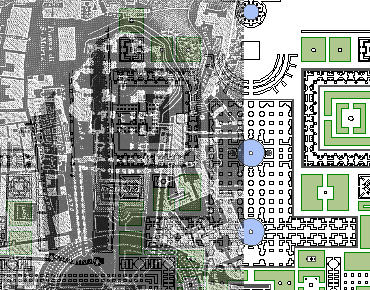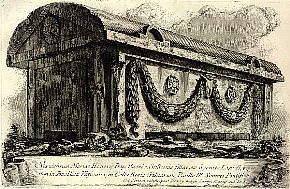Sep. Mariae Honorij Congiig.
1998.08.01
The Sepulchrum Mariae Honorij Congiig., the tomb of Empress Maria the first wife of Honorius, is the second to last building of ancient Rome designated within the Ichnographia Campus Martius. Piranesi mistakenly represents the tomb of Maria as separate from the tomb of Honorius; Maria's death may well have been the reason Honorius erected his family mausoleum around 400. Despite Piranesi's incorrectness, the position of Maria's tomb on the large plan falls within the area of the Vatican Hill that is actually occupied by St. Peter's Basilica, thus adding some veracity to the sepulcher's location. Moreover, Maria's tomb is within a courtyard surrounded on three sides by what appear to be other sepulchers whose placement within the Ichnographia partially coincides with the necropolis still in existence under St. Peter's Basilica, which is the traditionally held burial place of St. Peter himself. Another interesting detail is Piranesi's placement of Maria's tomb directly in front of the Templum Apollonis that is attached to the Circus of Caligula and Nero. According to "The Life of Sylvester" within the Liber Pontificalis, the original St. Peter's Basilica was built "in the shrine of Apollo," thus indicating that Piranesi's placement of the sepulcher of Maria within the Ichnographia was not altogether incorrect, but rather subtly and cleverly making note of the ancient Rome's pagan to Christian inversion.
Saint Peter's Basilica
1998.08.08
| |
The Basilican Church of Saint Peter, erected by the emperor Constantine c.330, was pulled down to make way for the present cathedral.
|
The Basilican Church of Saint Peter was erected by the emperor Constantine c.330 over the tomb of Saint Peter, which was also near Saint Peter's site of martyrdom in the Circus of Caligula and Nero. It is one of the largest imperial buildings constructed in Rome during the late years of the Empire. As such, its plan should be represented within the Ichnographia Campus Martius, however, it is not. Instead Piranesi fills the Vatican Valley with the elaborate Garden of Nero whose placement here is archeologically correct, although Piranesi's plan of the garden is entirely his own. Hence, it is easy to surmise that Piranesi simply chose to "reconstruct" this portion of ancient Rome according to its first century condition, and such a theory is plausible except that Piranesi also chose to include the Tomb of Honorius within the Garden of Nero, a sizable structure that was actually attached to Saint Peter's Basilica. The omission of Christianity's foremost shrine from the large plan therefore heralds ambiguity.

| |
St. Peter's was founded by Constantine primarily as a covered cemetery and funerary hall, serving mainly for burials, commemorative banquets, and the veneration of a martyr, the Apostle Saint Peter. Its floor was covered with graves; funerary banquets were customary--Saint Augustine tells of them as late as about A.D. 400; mausolea crowded around its walls, one--S. Maria della Febbre--older than the church and surviving until the eighteenth century. St. Peter's was on an imperial estate out of town: on the shoulder of the Vatican Hill where it sloped down toward the Gardens of Nero. [The basilica] was placed on a large terrace created by filling in the pagan necropolis and the small Christian cult center therein; only the upper part of the niche, Saint Peter's memorial, remained above the floor level.
Richard Krautheimer, Rome: Profile of a City, 312-1308 (Princeton: Princton University Press, 1980), pp. 26-7.
A detail area of the Horti Neroniani with the Circus of Caligula and Nero (left) and the Porticus Neronianae (right) is superimposed with the coinciding portion of Nolli Plan of Rome.
|
Finding the location within the Ichnographia of where the Basilica of Saint Peter's should be, begins to disclose Piranesi's intent. For example, in actuality the altar of St. Peter's Basilica sits directly above Saint Peter's tomb, which is part of row of tombs, and a superimposition of the basilica's plan and the Ichnographia plainly indicates that Piranesi places a row sepulchers precisely where they ought to be. Furthermore, the basilican plan of the Porticus Neronianae is certainly a reference to the Basilica of Saint Peter's, albeit inverted. It is as if Piranesi located St. Peter's Basilica within the Ichnographia without actually delineating it. This illusory mode of operation, moreover, infuses double meaning into the buildings of the Horti Neroniani that Piranesi does draw. It therefore becomes evident that Piranesi's rendition of the Porticus Neronianae is an imaginative reminder that not only did Saint Peter suffer and die under Nero's persecution of the Christians, but that in the end it is Saint Peter, through Christ, that ultimately triumphs. There is thus no doubt that Piranesi clearly recognized the tremendous irony whereby the most hedonistic of imperial Roman gardens ultimately became Christianity's terrestrial and spiritual center.
| |
|
| |
Antoninus Elagabalus
1998.10.01
from: David Magie (translator), The Scriptores Historiae Augustae (Cambridge, MA: Harvard University Press, 1980), vol. II.
p. 113: Then, when he held his first audience with the senate, he gave orders that his mother should be asked to come into the senate-chamber. On her arrival she was invited to a place on the consuls' bench and there she took part in the drafting--that is to say, she witnessed the drafting up of the senate's decree. And Elagabalus was the only one of all of the emperors under whom a woman attended the senate like a man, just as though she belonged to the senatorial order.
He also established a senaculum, or woman's senate, on the Quirinal Hill. Before his time, in fact, a congress of matrons had met here, but only on certain festivals, or whenever a matron was presented with the insignia of a "consular marriage"--bestowed by the early emperors on their kinswomen, particularly on those whose husbands were not nobles, in order that they might not lose their noble rank.
p. 149-51: He gave a naval spectacle, it is said, on the Circus-canals, which had been filled with wine, and he sprinkled the peoples cloaks with perfume made from the wild grape; also he drove a chariot drawn by four elephants on the Vatican Hill [The circus Vaticanus was constructed by Caligula at the north end of the Janiculum (the present site of the Church of St. Peter). Under Nero it was the scene of the tortures inflicted on the Christians; see Tacitus, Annals, xv.44. The context of the present passage, however, seems to indicate that it was not this circus that was the scene of Elagabalus' exploit, but the immediate vicinity, generally known as Vaticanum, where remains of tombs have been discovered; see O. Richter, Topographie d. Stadt Rom, p. 280 f.], destroying the tombs which obstructed the way, and he harnessed four camels to a chariot at a private spectacle in the circus.
excerpts from Procopius
1998.10.06

Sarcophagus of the Empress Maria
The last imperial artifact of ancient Rome
2001.03.04
Burial of the sarcophagus containing the remains of Maria, the first wife of the Emperor Honorius, occurred circa 400 AD within the Mausoleum of Honorius, a structure then newly attached to the south transept of the original Basilica of Saint Peter.
|

